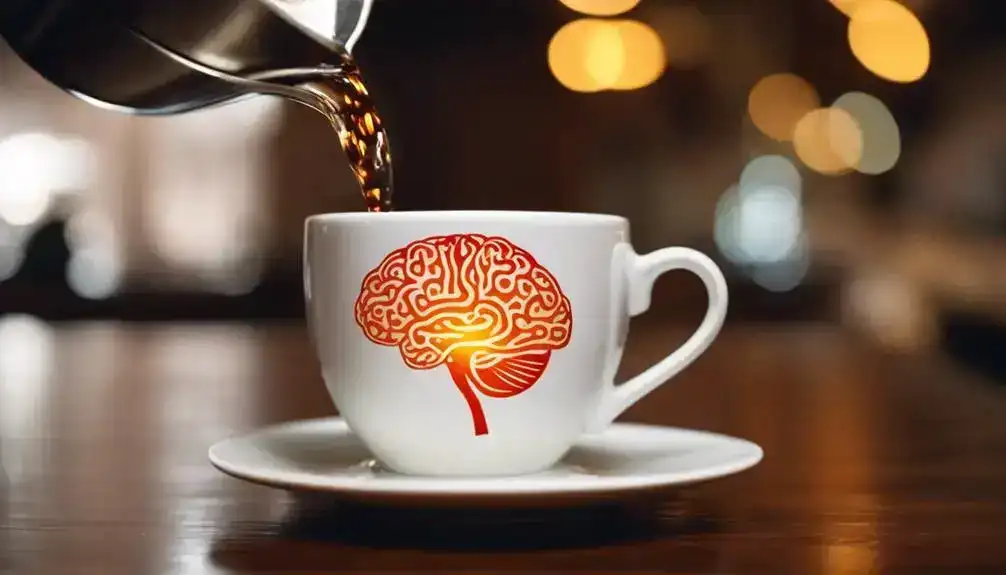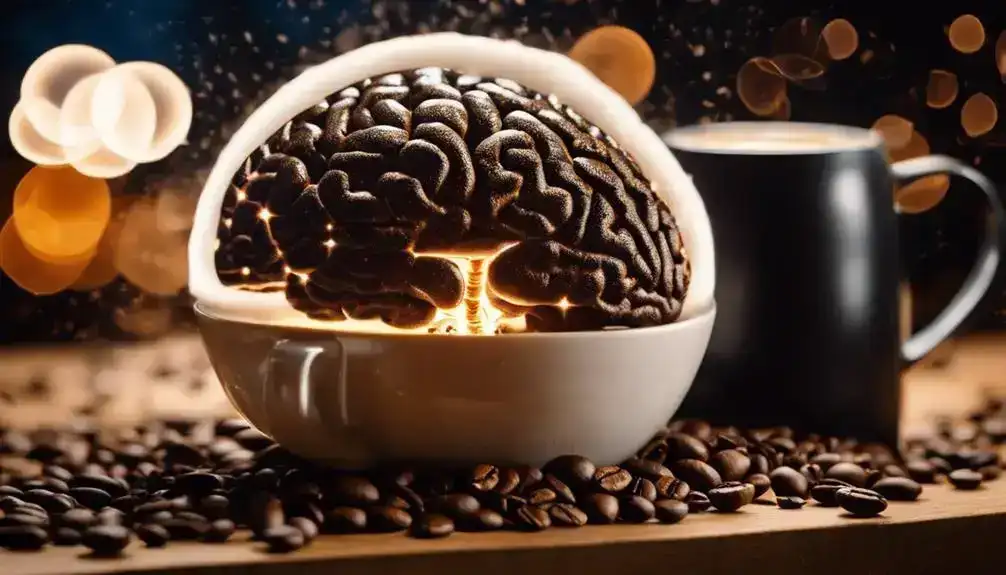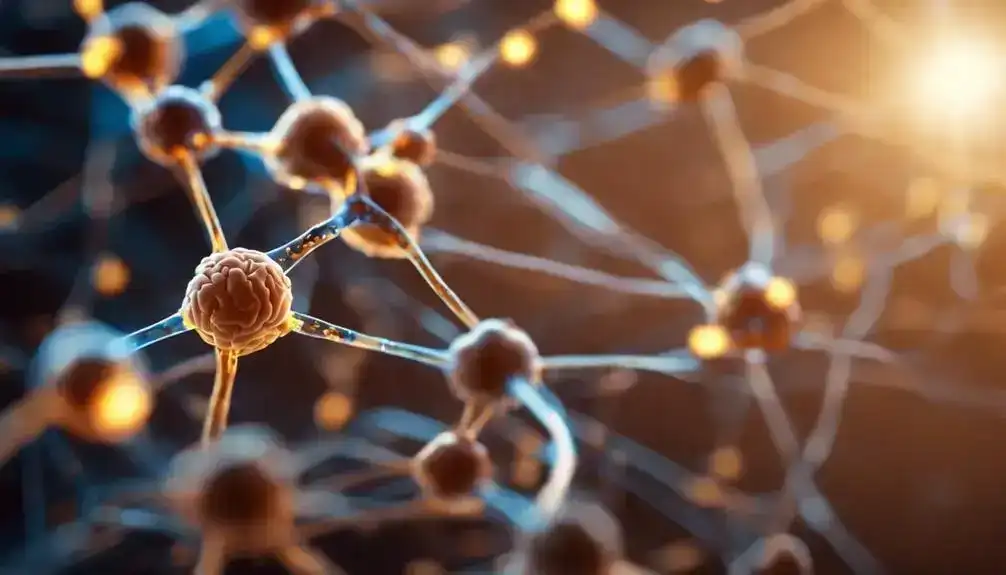When you drink coffee containing caffeine, the compound blocks adenosine receptors in your brain, preventing feelings of tiredness. Simultaneously, caffeine boosts dopamine levels, triggering pleasurable sensations.
This interaction makes your brain desire the heightened alertness and pleasure that caffeine provides, leading to addiction. So, the next time you reach for that cup of coffee, remember that it’s the caffeine altering your brain chemistry, making you crave more.
What is Caffeine Dependence?

Essential adenosine receptors and increasing dopamine levels, caffeine dependence is a condition where individuals develop a reliance on caffeine to function normally, often resulting in withdrawal symptoms when caffeine intake is reduced or stopped.
Addiction mechanisms involve the blocking of adenosine receptors, which usually induce relaxation, and the subsequent rise in dopamine levels, reinforcing the use of caffeine.
Psychological impacts of caffeine dependence include Mood Disturbances, anxiety, and impaired cognitive function.
Social factors, such as societal norms around caffeine consumption, can influence the development and maintenance of dependence.
Treatment options for caffeine dependence may involve gradual reduction in intake, behavioral therapies, and addressing underlying psychological issues that contribute to the addiction.
Understanding the complex interplay of biological, psychological, and social factors is essential in managing caffeine dependence effectively.
How Does Caffeine in Coffee Affect Your Brain?

When you consume coffee with caffeine, the adenosine receptors in your brain are blocked, leading to increased alertness and reduced feelings of tiredness. This mechanism alters your brain chemistry by enhancing dopamine release, which contributes to feelings of pleasure and reinforcement of caffeine consumption.
Over time, regular caffeine intake can result in behavioral effects such as improved mood, heightened alertness, and potential dependence.
The Role of Adenosine Receptors in Caffeine Addiction
When you consume caffeine in coffee, it blocks adenosine receptors in your brain, which are responsible for promoting sleep and relaxation. By inhibiting these receptors, caffeine increases alertness and prevents you from feeling tired.
Additionally, this blocking of adenosine receptors leads to a surge in dopamine levels, contributing to feelings of pleasure and reinforcing the habit of caffeine consumption.
How Caffeine Blocks Adenosine Receptors
caffeine in coffee impacts your brain by interfering with adenosine receptors, altering their normal functioning and leading to increased alertness and arousal.
This interference occurs due to caffeine molecules resembling adenosine, fitting into its receptors and preventing its calming effects. The result is heightened brain activity and the blocking of signals typically associated with tiredness, keeping you awake and alert.
- Caffeine interferes with adenosine receptors
- Alters normal receptor functioning
- Prevents calming effects
- Increases brain activity
- Blocks signals of tiredness
The Impact on Dopamine Levels
Blocking adenosine receptors due to caffeine consumption leads to an increase in dopamine levels in the brain, contributing to enhanced feelings of pleasure and reinforcing the use of caffeine.
- dopamine regulation plays a vital role in addiction mechanisms.
- Increased dopamine levels from caffeine create pleasurable sensations.
- Dopamine release reinforces the desire for more caffeine.
- Enhanced dopamine signaling contributes to the addictive nature of caffeine.
- Understanding dopamine’s impact is key in managing caffeine addiction.
Behavioral Effects of Caffeine
When you consume caffeine, it impacts your brain in various ways, leading to both positive and negative behavioral effects. Caffeine can enhance your feelings of well-being and sociability, increasing alertness and creating a preference for certain flavors.
However, regular consumption may also result in tolerance, withdrawal symptoms like headaches and fatigue, and can be influenced by genetic factors. As you explore the behavioral effects of caffeine, consider the intricate interplay between your brain chemistry and your daily habits.
- Positive Feelings and Alertness
- Reinforcement and Taste Preference
- Common Withdrawal Symptoms
- Developing Tolerance
- Genetic Factors in Caffeine Dependence
Positive Feelings and Alertness
Enhancing feelings of well-being and sociability, consuming caffeine in coffee boosts alertness and positive moods. This heightened state can lead to improved performance and interactions with others.
Caffeine achieves this by blocking adenosine receptors, preventing tiredness signals in the brain. Additionally, it stimulates dopamine release, enhancing pleasure and alertness.
These effects make caffeine a go-to choice for many seeking a mental and social boost.
Reinforcement and Taste Preference
Caffeine consumption in coffee can lead to the reinforcement of certain behaviors and the development of taste preferences due to its effects on the brain’s reward system.
Reinforcement mechanisms strengthen the association between caffeine intake and positive outcomes, encouraging continued consumption.
Additionally, taste preferences can form through the pairing of caffeine with specific flavors, further solidifying the habit of consuming coffee for its stimulating effects on the brain.
Common Withdrawal Symptoms
Common withdrawal symptoms from caffeine, such as headaches, fatigue, and mood disturbances, often prompt individuals to continue consumption to alleviate these effects.
- Headaches: Throbbing or dull headaches may occur.
- Fatigue: Feeling unusually tired or lacking energy.
- Mood Disturbances: Irritability, anxiety, or mood swings.
- Managing Cravings: Finding alternative activities to distract from cravings.
- Coping Strategies: Engaging in relaxation techniques to ease symptoms.
Developing Tolerance
Regular consumption of caffeine leads to the development of tolerance, necessitating higher doses to achieve the same desired effects over time.
As your body becomes accustomed to caffeine, it adapts by increasing tolerance, requiring more caffeine to produce the initial effects.
managing withdrawal symptoms may become challenging as you adjust to higher doses, potentially leading to a cycle of increased consumption to counteract tolerance.
Genetic Factors in Caffeine Dependence
Developing tolerance to caffeine involves genetic factors that contribute to variations in adenosine receptors and caffeine metabolism, influencing an individual’s susceptibility to caffeine dependence.
Genetic predisposition plays a significant role in determining how your body processes and responds to caffeine.
Understanding these genetic influences can aid in tailoring treatment options, including behavioral interventions, to manage caffeine dependence effectively based on your unique genetic makeup and caffeine metabolism.
How is Caffeine Addiction Diagnosed?

To diagnose caffeine addiction, healthcare professionals use the DSM-5 criteria for Caffeine Use Disorder, which assesses problematic caffeine consumption leading to impairment. Understanding the prevalence and cultural factors surrounding caffeine dependence is essential in diagnosing and addressing this condition effectively.
functional impairment resulting from caffeine dependence can impact various aspects of daily life, highlighting the importance of early diagnosis and intervention.
DSM-5 Criteria for Caffeine Use Disorder
The DSM-5 criteria for diagnosing Caffeine Use Disorder provide specific guidelines for identifying individuals who exhibit problematic patterns of caffeine consumption leading to significant impairment or distress.
When considering if someone may have Caffeine Use Disorder, the following criteria are taken into account:
- Persistent Desire: You have a persistent desire or unsuccessful efforts to cut down or control caffeine use.
- Continued Use: Despite knowledge of recurrent health problems related to excessive caffeine consumption, you continue to use it.
- Withdrawal Symptoms: You experience withdrawal symptoms like headache, fatigue, or irritability when attempting to cut down caffeine intake.
- Tolerance: You need to consume more caffeine to achieve the desired effect.
- Impairment or Distress: Your caffeine consumption leads to significant impairment in social, occupational, or other important areas of functioning.
Prevalence and Cultural Factors
Based on specific criteria outlined in diagnostic guidelines, healthcare professionals identify individuals with Caffeine Use Disorder by evaluating persistent patterns of consumption that lead to significant impairment or distress. Cultural influences play a role in the prevalence rates of caffeine addiction, with varying levels observed across different societies.
Factors such as dietary habits and social norms can impact the likelihood of developing caffeine dependence. Understanding the cultural context in which caffeine consumption occurs is essential for accurate diagnosis and effective treatment strategies.
Functional Impairment from Caffeine Dependence
Diagnosing caffeine addiction involves evaluating persistent patterns of consumption that result in significant impairment or distress, following specific diagnostic criteria outlined by healthcare professionals.
Individuals experiencing functional impairment from caffeine dependence may face challenges in various aspects of their lives, including social interactions, work performance, and overall well-being.
The social stigma associated with caffeine addiction can lead to feelings of shame or guilt, further exacerbating the impact on mental health.
In the workplace, decreased productivity and difficulties concentrating may arise, affecting job performance and career advancement opportunities.
Recognizing these functional impairments is essential in addressing caffeine addiction and seeking appropriate support to mitigate its effects on daily functioning and quality of life.
What is the Evidence for Caffeine Addiction?

Evidence for caffeine addiction is supported by studies indicating a notable percentage of caffeine users meeting the criteria for dependence. High-risk groups, such as individuals with psychiatric disorders or pregnant women, show increased prevalence of caffeine dependence, underscoring its impact on diverse populations.
The daily life impacts of caffeine addiction extend to issues with sleep, anxiety, and social interactions, emphasizing the need for further research and targeted interventions.
Studies on General Populations
Studies conducted on general populations provide valuable insights into the prevalence and impact of caffeine addiction among diverse groups of individuals. Research on population demographics reveals that caffeine addiction patterns vary across different age groups, genders, and cultural backgrounds.
For instance, studies have shown that younger individuals tend to have higher rates of caffeine dependence compared to older age groups. Additionally, there are differences in addiction prevalence based on geographical locations and socioeconomic statuses.
Understanding these demographic factors is essential for developing targeted interventions and support systems to address caffeine addiction effectively. By analyzing addiction patterns within general populations, researchers can tailor strategies to mitigate the negative consequences of caffeine dependence and promote healthier consumption habits among various segments of society.
High-Risk Groups for Caffeine Dependence
Certain high-risk groups, such as individuals with psychiatric disorders or pregnant women, exhibit a higher prevalence of caffeine dependence compared to the general population. Understanding the factors contributing to this increased susceptibility is essential in addressing the specific needs of these groups.
- pregnancy risks: Pregnant women metabolize caffeine differently, leading to prolonged exposure and potential adverse effects on the developing fetus.
- Mental health: Individuals with psychiatric disorders may use caffeine to self-medicate or manage symptoms, increasing the risk of dependence.
- Hormonal influences: Fluctuations in hormones during pregnancy or in psychiatric conditions can impact caffeine sensitivity and addiction vulnerability.
- Medication interactions: Psychiatric medications or pregnancy-related drugs can interact with caffeine, altering its effects and addictive potential.
- Stress and coping mechanisms: Both pregnant women and individuals with psychiatric disorders may use caffeine as a coping mechanism for stress, contributing to dependence.
Daily Life Impacts of Caffeine Addiction
Pregnant women and individuals with psychiatric disorders are at higher risk for developing caffeine dependence, leading to significant impacts on their daily lives. Caffeine addiction can disrupt social relationships as individuals may prioritize caffeine consumption over social interactions. This can lead to feelings of isolation and withdrawal from social activities.
Productivity levels are also affected, with caffeine dependence potentially causing fluctuations in energy and focus throughout the day. The need for caffeine to function normally can result in decreased productivity when individuals are unable to consume their usual amounts.
These impacts on social relationships and productivity highlight the challenges faced by individuals struggling with caffeine addiction and emphasize the importance of addressing this issue for overall well-being.
How Does Caffeine Impact Brain Chemistry?

When you consume caffeine, it swiftly enters your bloodstream, blocking the brain’s tiredness signals by inhibiting adenosine receptors, thereby promoting alertness.
Additionally, caffeine stimulates the release of dopamine, a neurotransmitter associated with pleasure and vigilance.
With regular intake, the brain adapts by increasing adenosine receptors, necessitating higher doses to achieve the same effects and leading to withdrawal symptoms upon cessation.
How Caffeine is Absorbed and Acts Quickly
Caffeine, upon consumption, rapidly absorbs into the bloodstream and promptly acts on the brain, influencing various neurochemical processes to enhance alertness and cognitive function. This quick action leads to noticeable effects on your brain chemistry, contributing to the addictive nature of caffeine.
Here are some key points to understand this process:
- Caffeine swiftly crosses the blood-brain barrier, reaching your brain within minutes.
- It blocks adenosine receptors, preventing the brain from receiving signals of tiredness.
- Dopamine release is stimulated, promoting feelings of pleasure and alertness.
- Brain function is altered, leading to increased neural activity and improved cognitive performance.
- Regular caffeine intake can result in changes in adenosine receptors, requiring higher doses for the same impact.
Blocking Tiredness Signals in the Brain
Upon consumption, caffeine rapidly crosses the blood-brain barrier, where it acts by blocking adenosine receptors to prevent the brain from receiving signals of tiredness.
Adenosine is a neurotransmitter that accumulates during wakefulness, leading to brain fatigue and cognitive exhaustion. By inhibiting adenosine’s actions, caffeine promotes wakefulness and alertness, keeping you engaged and focused.
This blockade of tiredness signals allows you to experience sustained mental clarity and enhanced cognitive function without the usual feelings of drowsiness. Consequently, you feel more energized and ready to tackle tasks that require attention and concentration.
Understanding how caffeine interferes with adenosine receptors sheds light on its ability to counteract the effects of sleep pressure, providing a temporary reprieve from the natural drive to rest.
Stimulating Dopamine Release for Alertness
Stimulating dopamine release in the brain is an essential mechanism by which caffeine enhances alertness and cognitive function. Dopamine, a neurotransmitter associated with pleasure and reward, plays a pivotal role in regulating motivation and alertness.
When you consume caffeine, it triggers the release of dopamine, leading to increased feelings of pleasure and heightened alertness. This neurotransmitter regulation is a key component of caffeine’s impact on your brain chemistry, influencing your cognitive performance and mood.
Brain Changes with Regular Caffeine Use
Consuming caffeine regularly leads to notable changes in the brain’s chemistry, particularly impacting adenosine receptors and dopamine levels. With continued use, the brain adapts by increasing the number of adenosine receptors, reducing caffeine’s effectiveness over time. This phenomenon, known as brain plasticity, underlies the development of tolerance to caffeine.
As adenosine receptors become desensitized, higher doses of caffeine are needed to achieve the same stimulating effects. Additionally, the increase in dopamine levels from prolonged caffeine consumption can influence cognitive effects, such as improved focus and alertness.
These changes in brain chemistry highlight the intricate relationship between caffeine intake, brain plasticity, and cognitive effects, emphasizing the need for moderation in caffeine consumption to avoid tolerance and maintain cognitive benefits.
Withdrawal Symptoms from Stopping Caffeine
Regular consumption of caffeine can lead to withdrawal symptoms upon cessation, affecting brain chemistry and overall well-being. When you decide to stop caffeine intake, you may experience:
- Headaches: Common withdrawal symptom due to changes in blood flow and the brain’s adjustment.
- Fatigue: Feeling tired and lethargic as your body adjusts to lower stimulation.
- Irritability: Changes in neurotransmitter levels can lead to mood disturbances.
- Difficulty Concentrating: Adenosine rebound effect can affect focus and attention.
Coping Strategies: Engage in relaxation techniques, stay hydrated, and gradually reduce caffeine intake to manage withdrawal symptoms and support your mental health.
What is the Mechanism Behind Caffeine Addiction?

When you consume caffeine regularly, your brain undergoes physical changes, such as an increase in adenosine receptors, leading to tolerance and withdrawal symptoms.
The habitual use of caffeine is reinforced by its positive effects on mood, alertness, and social interactions.
While caffeine addiction is milder compared to substances like nicotine or amphetamines, it still involves tolerance and withdrawal, a fact recognized by health organizations like the WHO.
Physical Brain Changes from Caffeine
Blocking adenosine receptors in the brain due to caffeine consumption leads to physical changes that contribute to the mechanism behind caffeine addiction.
Regular intake of caffeine results in increased adenosine receptors in the brain, leading to a phenomenon known as brain plasticity. This adaptation causes a tolerance to the effects of caffeine, requiring higher doses to achieve the same cognitive function enhancement.
As the brain adjusts to the presence of caffeine, it becomes reliant on the blocking of adenosine receptors for maintaining alertness and focus. This process can also lead to withdrawal symptoms when caffeine intake is reduced, highlighting the significant impact of caffeine on the brain’s functioning and the development of addiction.
Behavioral Aspects of Caffeine Addiction
Caffeine addiction involves behavioral aspects that are reinforced by the positive effects of caffeine on mood, alertness, and social interactions. Habit formation plays an essential role in caffeine addiction, as the repeated consumption of caffeine can lead to a habitual pattern of use.
This habit is often influenced by social influences, such as the normalization of coffee breaks in social settings or the association of caffeine consumption with productivity. The positive feelings and increased alertness experienced after consuming caffeine can further strengthen this habit loop, making it challenging to break free from caffeine dependence.
Understanding these behavioral aspects is vital in addressing caffeine addiction and developing effective strategies for managing consumption.
Comparing Caffeine to Other Addictive Substances
The mechanism underlying caffeine addiction involves physical changes in the brain and reinforcement through behavioral patterns. When comparing caffeine to other addictive substances, while caffeine dependence is milder than addiction to substances like nicotine or amphetamines, it still involves tolerance and withdrawal. This is due to similarities in brain chemistry and the impact on mental health across different substances. Below is a table highlighting key points:
| Addiction Comparisons | Substance Similarities |
|---|---|
| Caffeine | Mild addiction compared to substances like nicotine or amphetamines |
| Nicotine | Strong addictive potential, similar to caffeine in enhancing dopamine release |
| Amphetamines | Severe addiction potential, leading to significant behavioral and health consequences |
| Alcohol | Moderate addiction risk, affecting brain chemistry and cognitive functions |
Comparing these substances can provide insights into the varying degrees of addiction and their effects on mental health.
Recognition by Health Organizations
Health organizations globally recognize caffeine dependence as a clinical disorder due to its potential impact on public health. This recognition by professionals emphasizes the importance of understanding and addressing the addictive nature of caffeine.
Here are some key points regarding public awareness and recognition of caffeine addiction:
- Caffeine dependence is acknowledged as a significant health concern.
- Health organizations raise awareness about the risks associated with excessive caffeine consumption.
- Professionals advocate for better understanding and management of caffeine addiction.
- Public education campaigns aim to inform individuals about the potential dangers of caffeine dependence.
- Ongoing research is conducted to improve diagnostic tools and treatment strategies for caffeine addiction.
How Can You Manage and Overcome Caffeine Addiction?

To manage and overcome caffeine addiction, it’s essential to recognize withdrawal symptoms like headaches, fatigue, irritability, and concentration difficulties. These symptoms can vary in duration and intensity based on the level of dependence, lasting from a few days to a week or more.
Gradual reduction strategies, such as mixing decaf with regular coffee or choosing lower caffeine alternatives, can help, while severe cases may require professional help like counseling or support groups.
Recognizing Withdrawal Symptoms
Identifying withdrawal symptoms is essential in managing and overcoming caffeine addiction effectively. When recognizing these symptoms, consider the following coping mechanisms and lifestyle changes to navigate your journey towards freedom:
- Stay Hydrated: Drinking plenty of water can help alleviate headaches and fatigue.
- Exercise Regularly: Physical activity can boost your mood and energy levels during withdrawal.
- Practice Mindfulness: Mindfulness techniques like deep breathing can help manage irritability and restlessness.
- Get Sufficient Sleep: Prioritize quality sleep to combat fatigue and improve overall well-being.
- Gradual Reduction: Slowly decreasing caffeine intake can minimize withdrawal intensity and make the process more manageable.
Duration and Intensity of Withdrawal
Recognizing the duration and intensity of withdrawal symptoms is crucial in effectively managing and overcoming caffeine addiction. Withdrawal symptoms from caffeine cessation can last from a few days to a week or longer. The intensity of these symptoms varies based on the level of dependence one has developed.
To manage the duration and reduce the intensity of withdrawal, gradual reduction of caffeine intake is recommended. This can involve slowly decreasing the amount of caffeine consumed each day to allow your body to adjust more smoothly. Additionally, staying hydrated, getting enough rest, and engaging in physical activity can help alleviate some of the intensity of withdrawal symptoms.
Taking these steps can support your journey towards overcoming caffeine addiction.
Tips for Gradually Reducing Caffeine
Gradually reducing your caffeine intake can be an effective strategy in managing and overcoming caffeine addiction. To help you in this process, consider the following tips:
- Mix decaf with regular coffee: Gradually decreasing the caffeine content in your coffee by mixing decaf with regular coffee can ease the adjustment.
- Choose lower caffeine alternatives: Opt for alternative beverages like herbal teas, green tea, or caffeine-free sodas to reduce your overall caffeine intake.
- Set time limits for caffeine intake: Establish specific times during the day when you allow yourself to consume caffeinated beverages to control your caffeine consumption.
- Incorporate lifestyle changes: Engage in activities that promote relaxation and well-being to reduce the reliance on caffeine for energy.
- Explore alternative beverages: Experiment with drinks like decaffeinated coffee, herbal infusions, or fruit juices as replacements for caffeinated beverages.
Seeking Professional Help for Severe Cases
To address severe cases of caffeine addiction, seeking professional help, such as counseling or participation in support groups, may be necessary to effectively manage withdrawal symptoms and underlying issues.
Support groups provide a platform for individuals to share experiences, receive encouragement, and learn coping strategies from others facing similar challenges. Therapeutic approaches offered by trained professionals can help you navigate the complexities of caffeine addiction, addressing both the physical and psychological aspects of dependence.
Counseling sessions can aid in understanding the root causes of addiction, developing personalized strategies for withdrawal, and building resilience against relapse. By engaging with support groups and therapeutic interventions, you can enhance your ability to manage and overcome severe caffeine addiction, leading to improved overall well-being.
What are the Future Directions in Caffeine Addiction Research?

Future directions in caffeine addiction research aim to enhance understanding of its prevalence across diverse populations.
Explore genetic factors and clinical manifestations to refine diagnostic and treatment modalities for improved outcomes.
By investigating the extent of caffeine dependence, examining genetic influences, and advancing diagnostic tools, researchers seek to develop more targeted interventions.
This thorough approach will contribute to a deeper comprehension of caffeine addiction and pave the way for more effective management strategies.
Improving Understanding of Prevalence
Researchers are currently focusing on enhancing the understanding of the significance of caffeine dependence across diverse populations to inform future strategies for diagnosis and treatment.
Exploring prevalence factors involves investigating how cultural influences, dietary habits, and social norms impact the development of caffeine addiction. By delving deeper into these factors, researchers aim to identify high-risk groups and tailor interventions to address specific needs.
Understanding the prevalence of caffeine dependence is essential for developing targeted prevention and treatment approaches that consider the unique characteristics of different populations. By analyzing the cultural and social contexts surrounding caffeine consumption, researchers can uncover valuable insights that pave the way for more effective strategies to combat addiction and promote healthier habits regarding caffeine use.
Genetic and Clinical Research Needs
Improving genetic and clinical research in the field of caffeine addiction is vital for advancing our understanding of the underlying mechanisms and developing more targeted treatment strategies.
Research advancements in genetic studies can uncover specific gene variations that predispose individuals to caffeine dependence, shedding light on personalized treatment approaches.
By investigating the clinical aspects of caffeine addiction, such as withdrawal patterns and co-occurring disorders, researchers can tailor interventions to address individual needs effectively.
Understanding how genetic factors interact with environmental influences will be essential in enhancing diagnostic accuracy and treatment outcomes.
Future studies should aim to bridge the gap between genetics and clinical practice, ultimately leading to more precise and successful treatment approaches for caffeine addiction.
Enhancing Diagnostic and Treatment Methods
To advance the field of caffeine addiction research, further exploration into diagnostic and treatment methods is essential for improving patient outcomes and addressing the complexities of caffeine dependence.
Refining treatment approaches and diagnostic criteria advancements are pivotal in enhancing the management of caffeine addiction.
Future research should focus on developing more precise diagnostic tools to accurately identify individuals struggling with caffeine dependence.
Additionally, investigating novel treatment strategies that target specific pathways involved in caffeine addiction can lead to more effective interventions.
By continuously refining diagnostic methods and treatment approaches, healthcare professionals can better assist individuals in overcoming caffeine addiction and improving their overall well-being.
This ongoing research aims to provide tailored and evidence-based care to individuals affected by caffeine dependence, ultimately enhancing treatment outcomes.
Conclusion
As you journey through the intricate world of caffeine addiction, you’ll find that the brain’s cravings for that daily cup of coffee are as complex as a tangled web of neurons.
Unraveling the mechanisms behind this dependency reveals a delicate balance of neurotransmitters and receptors, shaping your daily routine and affecting your brain chemistry.
The next time you reach for that steaming mug, remember the intricate dance of brain cravings that caffeine addiction entails.

